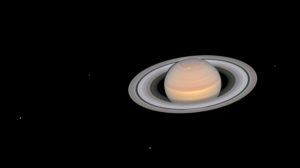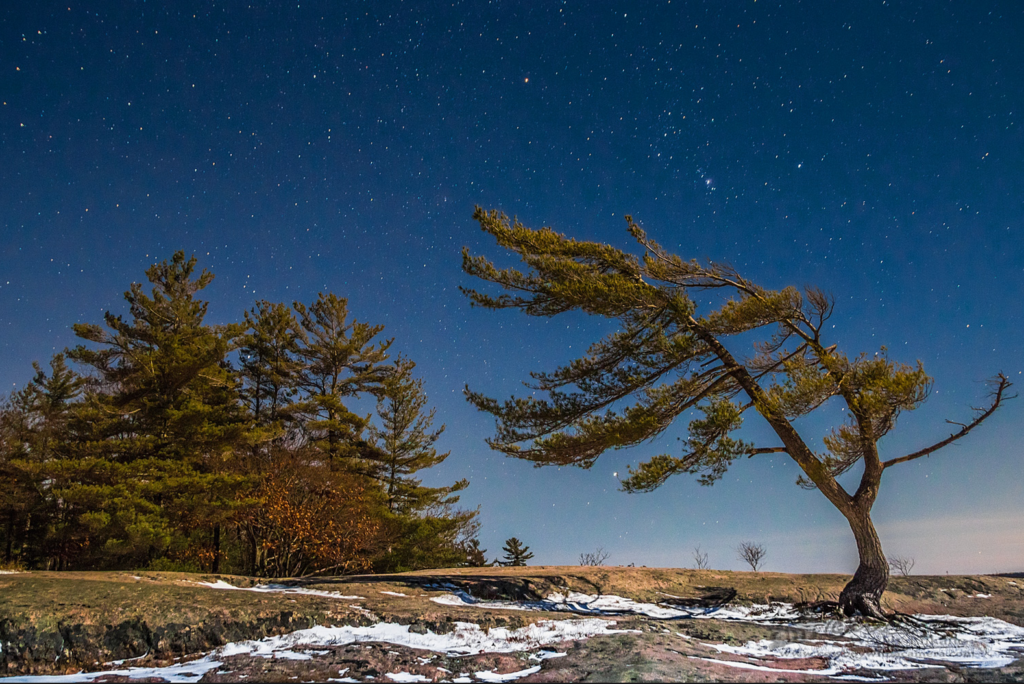
The year 2024 is a busy one for celestial events and night sky sights. All the bright planets – especially Mercury and Mars – make spectacular appearances and a number of conjunctions through the year. A total solar eclipse passes across North America in early April. The Perseids arrive in August with the Moon mostly out of the way. And through the year, solar activity is expected to pick up resulting in increased sunspot counts and other chromospheric activity along with frequent auroral displays. We even get an extra day of stargazing since February has 29 days in 2024, a consequence of a calendar adjustment to account for the fact that it takes the Earth 365.25 days to go around the Sun, not 365. Here are the key celestial events for 2024. We’ll have more about each event, and much more, in the monthly night-sky updates on Cosmic Pursuits.
1. The Moon Occults Antares (January 8)
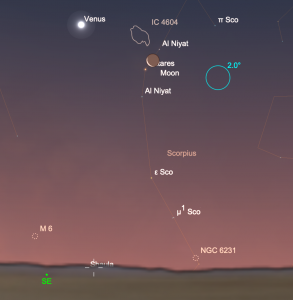 Observers everywhere see the Moon and Antares close together in the southeastern morning twilight sky with and Venus and Mercury nearby. But in much of western North America and parts of Mexico and the Caribbean, the Moon appears to pass in front of the star before sunrise or, in central North America, as the sun rises. You need a clear view of the southeastern horizon and binoculars or small telescope to see the event. Get precise timing of the disappearance and reappearance of Antares from hundreds of locations at this link.
Observers everywhere see the Moon and Antares close together in the southeastern morning twilight sky with and Venus and Mercury nearby. But in much of western North America and parts of Mexico and the Caribbean, the Moon appears to pass in front of the star before sunrise or, in central North America, as the sun rises. You need a clear view of the southeastern horizon and binoculars or small telescope to see the event. Get precise timing of the disappearance and reappearance of Antares from hundreds of locations at this link.
***
2. Moon Meets Up With The Pleiades (March 15)
A waxing crescent Moon passes within 0.4º of the Pleiades star cluster in the evening hours. Jupiter shines brightly in Aries to the southwest. Grab a pair of binoculars to take in the show.
***
3. Mercury Brightens in the Evening Sky (March 17)
 Mercury makes its best evening apparition of 2024 for northern-hemisphere observers. It shines at a brilliant magnitude -0.9 over the western horizon as the Sun sets. The planet also lies closest to the Sun in its orbit today. No bright stars shine nearby, but grab a telescope and examine the planet’s featureless disk (after the Sun goes down). Today it spans about 6.4″ and appears about 70% illuminated.
Mercury makes its best evening apparition of 2024 for northern-hemisphere observers. It shines at a brilliant magnitude -0.9 over the western horizon as the Sun sets. The planet also lies closest to the Sun in its orbit today. No bright stars shine nearby, but grab a telescope and examine the planet’s featureless disk (after the Sun goes down). Today it spans about 6.4″ and appears about 70% illuminated.
***
4. Venus in Conjunction with Saturn (March 22)
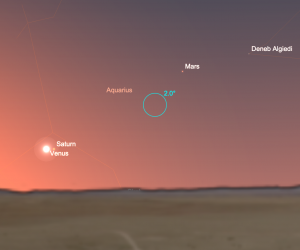 Venus passes just 0.3° N of Saturn in the southeastern sky before sunrise. The pair lie about 16° from the Sun, but the angle of the ecliptic means northern observers see them just barely above the horizon. Southern observers get a better view. A pair of binoculars or small telescope help extract the planets from the morning twilight.
Venus passes just 0.3° N of Saturn in the southeastern sky before sunrise. The pair lie about 16° from the Sun, but the angle of the ecliptic means northern observers see them just barely above the horizon. Southern observers get a better view. A pair of binoculars or small telescope help extract the planets from the morning twilight.
***
5. Three Planets and a Crescent Moon (April 6)
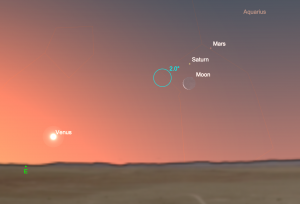 Look again to the southeast before sunrise to see Mars, Saturn, and a wafer-thin crescent Moon all within a 5º circle. It’s a perfect vista for a pair of binoculars. Venus lies eastward just over the horizon.
Look again to the southeast before sunrise to see Mars, Saturn, and a wafer-thin crescent Moon all within a 5º circle. It’s a perfect vista for a pair of binoculars. Venus lies eastward just over the horizon.
***
6. A Total Solar Eclipse Passes Across North America (April 8)
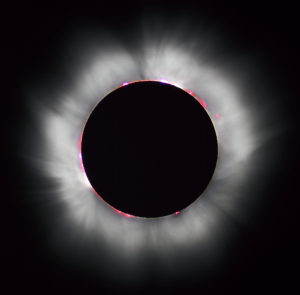
It’s arguably the most spectacular celestial event of the year – the great ‘North American Eclipse’ as the Moon’s shadow passes across North America from Mexico, across the United States, and in to eastern Canada. The total solar eclipse passes across major cities from Mazatlan (Mexico) to Dallas, Little Rock, Indianapolis, Cleveland, Buffalo, Niagara Falls, Montreal, and beyond. Millions of people will be on the move to the narrow path of totality. And hundreds of millions more can see a partial eclipse to some degree across most of North America. More details and a video of the path of totality at this link.
***
7. Mars and Saturn in Conjunction (April 11)
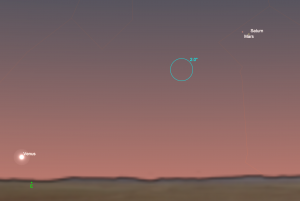 Mars does not reach opposition in 2024, but it still puts on a show, making close conjunctions with several planets before brightening and growing bigger by year’s end. Today the planet lies about 0.5ºN of Saturn in the southeastern morning twilight sky. Binoculars – or even better, a small telescope – enhance the view. Each planet has almost the same brightness, just a shade fainter than 1st magnitude. But a telescope shows Saturn with a disk about 15″ across while Mars spans a puny 4.6″.
Mars does not reach opposition in 2024, but it still puts on a show, making close conjunctions with several planets before brightening and growing bigger by year’s end. Today the planet lies about 0.5ºN of Saturn in the southeastern morning twilight sky. Binoculars – or even better, a small telescope – enhance the view. Each planet has almost the same brightness, just a shade fainter than 1st magnitude. But a telescope shows Saturn with a disk about 15″ across while Mars spans a puny 4.6″.
***
8. Mars and Neptune in Close Conjunction (April 28-29)
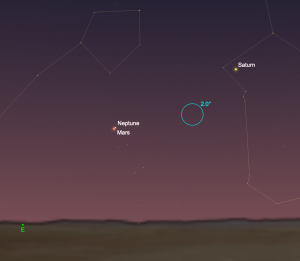 Mars continues its series of conjunctions this year with a near pass of the ice giant Neptune, the most distant planet in our solar system. The two planets nearly graze each other, passing within 0.04° at 4:00 UT on April 29. This rare sight requires a telescope to show the two tiny disks; Neptune is too faint to see without optics. Mars appears a little over twice as large as tiny Neptune but far brighter. While neither planet shows a spectacular disk, it’s worth taking in this rare vista in the early-morning hours before twilight obscures the fainter planet.
Mars continues its series of conjunctions this year with a near pass of the ice giant Neptune, the most distant planet in our solar system. The two planets nearly graze each other, passing within 0.04° at 4:00 UT on April 29. This rare sight requires a telescope to show the two tiny disks; Neptune is too faint to see without optics. Mars appears a little over twice as large as tiny Neptune but far brighter. While neither planet shows a spectacular disk, it’s worth taking in this rare vista in the early-morning hours before twilight obscures the fainter planet.
***
9. Saturn, Mars, Neptune and the Moon (May 4)
Mars and Neptune have pulled apart in the southeastern morning sky, but today a slender crescent Moon joins the show along with Saturn.
***
10. A Good Year for the Eta Aquarid Meteor Shower (May 5-6)
 The usually reliable Eta Aquarid meteor shower runs from April 21 – May 20 each year with many meteors still visible for several days on either side of the peak on May 5-6. This is perhaps the best meteor shower of the year for southern hemisphere stargazers, and this year the Moon stays out of the way. The annual Eta Aquarids occur as Earth passes through an stream of icy and dusty debris from the famous Comet 1/P Halley, more commonly called Halley’s Comet. As the Earth turns into the meteor stream after midnight, more Eta Aquarids become visible. You don’t need to find the star Eta Aquarii to see the meteors. They can appear anywhere in the sky. Nor do you need optics… just lie back under dark sky and look up.
The usually reliable Eta Aquarid meteor shower runs from April 21 – May 20 each year with many meteors still visible for several days on either side of the peak on May 5-6. This is perhaps the best meteor shower of the year for southern hemisphere stargazers, and this year the Moon stays out of the way. The annual Eta Aquarids occur as Earth passes through an stream of icy and dusty debris from the famous Comet 1/P Halley, more commonly called Halley’s Comet. As the Earth turns into the meteor stream after midnight, more Eta Aquarids become visible. You don’t need to find the star Eta Aquarii to see the meteors. They can appear anywhere in the sky. Nor do you need optics… just lie back under dark sky and look up.
***
11. The Moon Occults Saturn (May 31)
A waxing crescent Moon comes within half a degree of Saturn this evening, not an unusual sight in itself, but still a fine view in a pair of binoculars. Observers in South America and Africa see the closest approach, and the Moon does in fact pass in front of the ringed planet for observers in southern South America and Central Africa (but not South Africa). Find the timing and path of this occultation at this link.
***
12. Mars in Conjunction with Uranus (July 15)
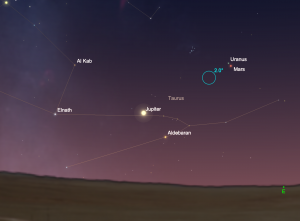 Mars is at it again as it makes a close conjunction with Uranus in the eastern sky before sunrise. The Red Planet lies 0.6ºS of Uranus. Both planets lie in Taurus about 6º south of the Pleiades. If you observe the pair before the sky gets too bright, you might be able to spot Uranus without optics with Mars showing the way. But even the smallest optics will reveal the pair. At magnitude +0.9, Mars outshines distant Uranus (magnitude 5.8). They are much closer in apparent size with Mars spanning 5.6″ and Uranus about 3.5″.
Mars is at it again as it makes a close conjunction with Uranus in the eastern sky before sunrise. The Red Planet lies 0.6ºS of Uranus. Both planets lie in Taurus about 6º south of the Pleiades. If you observe the pair before the sky gets too bright, you might be able to spot Uranus without optics with Mars showing the way. But even the smallest optics will reveal the pair. At magnitude +0.9, Mars outshines distant Uranus (magnitude 5.8). They are much closer in apparent size with Mars spanning 5.6″ and Uranus about 3.5″.
***
13. Mercury Rises in the Evening Sky (July 22)
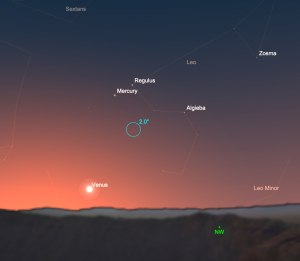 Mercury makes its best evening apparition for the year for southern-hemisphere observers. The planet lies well above Venus, which has returned to the evening sky, and not far from the bright star Regulus. The planet shines at magnitude +0.5, a little brighter than Regulus. In a telescope, you see the little planet’s disk span about 8″ with 43% of its face illuminated.
Mercury makes its best evening apparition for the year for southern-hemisphere observers. The planet lies well above Venus, which has returned to the evening sky, and not far from the bright star Regulus. The planet shines at magnitude +0.5, a little brighter than Regulus. In a telescope, you see the little planet’s disk span about 8″ with 43% of its face illuminated.
***
14. The Perseid Meteor Shower Peaks (August 11-12)
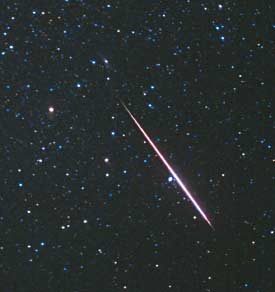 The Perseids is the finest meteor shower of the year for northern stargazers, with 40-60 meteors per hour visible at the peak in the hours before dawn on August 12. Once called the Tears of St. Lawrence, this meteor shower occurs as the Earth moves through a stream of debris left by Comet Swift-Tuttle. This year a first-quarter Moon stays out of the way for the best part of the shower after midnight. Stay away from city lights, if you can, and you will be rewarded with a bright meteor every minute or two, no optics required. Just lie back on a blanket and enjoy the show.
The Perseids is the finest meteor shower of the year for northern stargazers, with 40-60 meteors per hour visible at the peak in the hours before dawn on August 12. Once called the Tears of St. Lawrence, this meteor shower occurs as the Earth moves through a stream of debris left by Comet Swift-Tuttle. This year a first-quarter Moon stays out of the way for the best part of the shower after midnight. Stay away from city lights, if you can, and you will be rewarded with a bright meteor every minute or two, no optics required. Just lie back on a blanket and enjoy the show.
***
15. Jupiter in Conjunction with Mars (August 14)
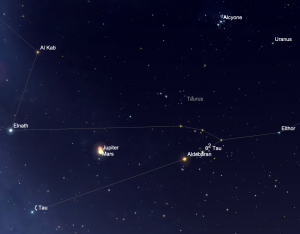 Mars makes its final conjunction with a bright planet this year as it lies about 0.3ºN of Jupiter. Both are tangled in the horns of Taurus before dawn. Mars is slowly brightening and growing larger and today shines at magnitude +0.8 with a disk about 6″ across, still quite tiny and unlikely to reveal much detail. Jupiter shines at magnitude -2.2 and spans almost 37″, still much smaller than it will appear at opposition but large enough, as always, to reveal some detail in a telescope. Eyes, binoculars, or telescope – all work great to witness this lovely conjunction.
Mars makes its final conjunction with a bright planet this year as it lies about 0.3ºN of Jupiter. Both are tangled in the horns of Taurus before dawn. Mars is slowly brightening and growing larger and today shines at magnitude +0.8 with a disk about 6″ across, still quite tiny and unlikely to reveal much detail. Jupiter shines at magnitude -2.2 and spans almost 37″, still much smaller than it will appear at opposition but large enough, as always, to reveal some detail in a telescope. Eyes, binoculars, or telescope – all work great to witness this lovely conjunction.
***
16. Moon and Saturn in Conjunction, Again (August 21)
As on May 31, most observers will see the Moon about half a degree from pale-yellow Saturn today. The Moon is just past full, about 17 days old. But observers in much of Central America, northern South America, and all of Europe will see the Moon pass in front of Saturn, always an event worth observing. Detailed timing of the occultation for many locations is available here.
***
17. Venus Meets the Crescent Moon at Twilight (September 5)
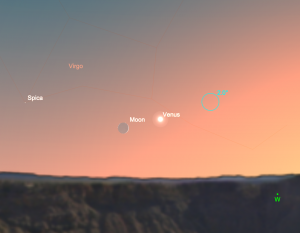 As day turns into evening, look for a very thin crescent Moon about 5° southeast of Venus over the southwestern horizon. The Moon is just 2.5 days old and about the same overall brightness as Venus, about magnitude -3.9, but you may need a pair of binoculars to spot the pair in the bright twilight. The bright star Spica lies about 10° to the east. Northern observers see the Moon and Venus quite close to the horizon, but southern observers see the pair more elevated as darkness falls. It’s an excellent – if challenging photo op.
As day turns into evening, look for a very thin crescent Moon about 5° southeast of Venus over the southwestern horizon. The Moon is just 2.5 days old and about the same overall brightness as Venus, about magnitude -3.9, but you may need a pair of binoculars to spot the pair in the bright twilight. The bright star Spica lies about 10° to the east. Northern observers see the Moon and Venus quite close to the horizon, but southern observers see the pair more elevated as darkness falls. It’s an excellent – if challenging photo op.
***
18. Saturn Reaches Opposition (September 8)
Saturn reaches opposition and rises in the east as the Sun sets in the west. The planet lies in the constellation Aquarius as it makes its closest approach to Earth this year at a distance of 8.66 AU. At opposition, its disk spans about 19” and its rings about 44”. But this year the planet presents an odd sight with its rings tilted just 3.3º from edge on. They look more like linear protuberances than rings.
***
19. Venus, Mercury, and the Moon Meet in the Evening Sky (November 5)
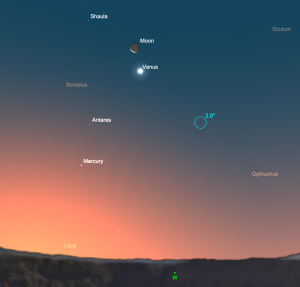 Southern-hemisphere observers can look to the west to see Mercury (magnitude -0.9), Venus (magnitude -4.0), Antares (magnitude +1.1), and the slender 3.5 day-old crescent Moon as evening twilight arrives. They’re all arranged in a shallow arc about 20º long (this image at left shows the view from 35ºS latitude). It’s another great photo-op, or simple sit back and enjoy the show as night falls. Northern observers can see the same arrangement but much closer to the horizon which makes the observation more difficult.
Southern-hemisphere observers can look to the west to see Mercury (magnitude -0.9), Venus (magnitude -4.0), Antares (magnitude +1.1), and the slender 3.5 day-old crescent Moon as evening twilight arrives. They’re all arranged in a shallow arc about 20º long (this image at left shows the view from 35ºS latitude). It’s another great photo-op, or simple sit back and enjoy the show as night falls. Northern observers can see the same arrangement but much closer to the horizon which makes the observation more difficult.
***
20. The Moon Occults Neptune (November 11)
Observers in North America (except for the northwest) see dim and distant Neptune pass behind the waxing gibbous Moon in the early evening hours. The planet appears to vanish behind the dark limb of the Moon and reappear behind the bright limb roughly about an hour later. It’s not a visually spectacular event, like a Saturn occultation, but it’s still worth seeing to experience the gravitational clockwork of the solar system in action. Detailed timing for hundreds of locations at this link.
***
21. Jupiter at Opposition
Jupiter reaches opposition, rising in the east as the sun sets in the west. The planet lies at a distance of about 596 million kilometres. Jupiter shines at a dazzling magnitude -2.9 tonight, brighter than anything else in the night sky except for the Moon and Venus. Its disk spans nearly 50″. The big planet lies well north of celestial equator, ideal for northern observers but still reasonably placed for those in the southern hemisphere. This is the best time of year to observe this immense gas giant, and the planet will remain well positioned in the evening sky for the next few months.
***
22. Ganymede and Europa Transit Jupiter (December 5-9)
You need a good telescope to see these events, but Jupiter’s big Galilean moons, Ganymede and Europa, transit the face of the planet near opposition. Transits are not particularly rare, but when they happen near opposition, the planet is led or trailed ever so slightly by its shadow. Since shadows are easier to see, they guide the eye to the harder-to-see moons themselves as they transit the planet. On Dec. 6 03:12 UT (Dec. 5 in the Americas), Europa trails its shadow by 1.5″ as the moon transits Jupiter. Then Ganymede transits on Dec. 9 at 03:56 UT with its shadow trailing by 11″, an event also best seen in the Americas. Later the same day, at 16:48 UT, observers in Europe can see Europa transit Jupiter trailed by its shadow just 1.5″ away. To make these observations, a telescope of at least 80mm aperture is a big help along with steady air and moderate to high magnification. Sky & Telescope has a useful calculator for predicting the transits of Jupiter’s Galilean moons at this link.
***
23. Mars and the Moon Meet Near the Beehive (December 18)
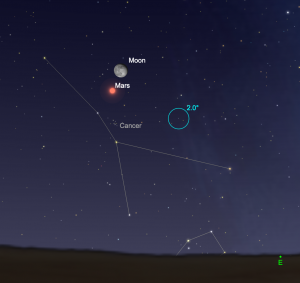 While attracting attention all year with a series of conjunctions with its fellow planets, Mars takes center stage as 2024 comes to a close. The planet has brightened to magnitude -0.9 and fattened to a size of 13.2″, and continues to do so on the way to opposition on January 16, 2025. Tonight the planet lies about one degree southeast of a fat gibbous Moon in the constellation Cancer and some 3º north of Messier 44, the Beehive star cluster. All worth taking in visually and in binoculars.
While attracting attention all year with a series of conjunctions with its fellow planets, Mars takes center stage as 2024 comes to a close. The planet has brightened to magnitude -0.9 and fattened to a size of 13.2″, and continues to do so on the way to opposition on January 16, 2025. Tonight the planet lies about one degree southeast of a fat gibbous Moon in the constellation Cancer and some 3º north of Messier 44, the Beehive star cluster. All worth taking in visually and in binoculars.
Share This:
